SST Indexes in the Tropical South Atlantic for Forecasting Rainy Seasons in Northeast Brazil
Abstract
1. Introduction
2. Data and Methods
3. Results
3.1. Results for Eastern NEB
3.2. Results for Northern NEB
3.3. Forecast Ability of the Southeastern Tropical Atlantic and Atlantic Niño Indexes
4. Summary and Conclusions
Author Contributions
Acknowledgments
Conflicts of Interest
References
- Hastenrath, S.; Heller, L. Dynamics of climatic hazards in Northeast Brazil. Q. J. R. Meteorol. Soc. 1977, 103, 77–92. [Google Scholar] [CrossRef]
- Moura, A.D.; Shukla, J. On the dynamics of droughts in northeast Brazil: Observations, theory and numerical experiments with a general circulation model. J. Atmos. Sci. 1981, 38, 2653–2675. [Google Scholar] [CrossRef]
- Servain, J.; Séva, M. On relationship between tropical Atlantic sea surface temperature, wind stress and regional precipitation indices: 1964–1984. Ocean-Air Interact. 1987, 1, 183–190. [Google Scholar]
- Hastenrath, S. Prediction of Northeast Brazil Rainfall Anomalies. J. Clim. 1990, 3, 893–904. [Google Scholar] [CrossRef]
- Servain, J. Simple climatic indices for the tropical Atlantic Ocean and some applications. J. Geophys. Res. 1991, 96, 15137–15146. [Google Scholar] [CrossRef]
- Ward, M.N.; Folland, C.K. Prediction of seasonal rainfall in the North Nordeste of Brazil using eigenvectors of Sea Surface Temperature. Int. J. Climatol. 1990, 11, 711–743. [Google Scholar] [CrossRef]
- Hastenrath, S.; Greischar, L. Circulation mechanisms related to Northeast Brazil rainfall anomalies. J. Geophys. Res. Atmos. 1993, 98, 5093–5102. [Google Scholar] [CrossRef]
- Hastenrath, S.; Greischar, L. Further work on the prediction of Northeast Brazil rainfall anomalies. J. Clim. 1993, 6, 743–758. [Google Scholar] [CrossRef]
- Nobre, P.; Shukla, J. Variation of sea surface temperature, wind stress, and rainfall over the tropical Atlantic and South America. J. Clim. 1996, 9, 2464–2479. [Google Scholar] [CrossRef]
- Chang, P.; Ji, L.; Li, H. A Decadal Climate Variation in the Tropical Atlantic Ocean from Thermodynamic Air-Sea Interactions. Nature 1997, 385, 516–518. [Google Scholar] [CrossRef]
- Hastenrath, S. Exploring the climate problems of Brazil’s Nordeste: A review. Clim. Chang. 2012, 112, 243–251. [Google Scholar] [CrossRef]
- Marengo, J.A.; Torres, R.R.; Alves, L.M. Drought in Northeast Brazil-past, present, and future. Theor. Appl. Climatol. 2017, 129, 1189–1200. [Google Scholar] [CrossRef]
- Nobre, P.; Marengo, J.A.; Cavalcanti, I.F.A.; Obregon, G.; Barros, V.; Camilloni, I.; Campos, N.; Ferreira, A.G. Seasonal-to-decadal predictability and prediction of South American Climate. J. Clim. 2006, 19, 5988–6004. [Google Scholar] [CrossRef]
- Uvo, C.R.B.; Repelli, C.A.; Zebiak, S.E.; Kushnir, Y. The relationships between tropical Pacific and Atlantic SST and northeast Brazil monthly precipitation. J. Clim. 1998, 11, 551–562. [Google Scholar] [CrossRef]
- Saravanan, R.; Chang, P. Interaction between Tropical Atlantic Variability and El Niño-Southern Oscillation. J. Clim. 2000, 13, 2177–2194. [Google Scholar] [CrossRef]
- Chiang, J.C.H.; Kushnir, Y.; Zebiak, S.E. Interdecadal changes in eastern Pacific ITCZ variability and its influence on the Atlantic ITCZ. Geophys. Res. Lett. 2000, 27, 3687–3690. [Google Scholar] [CrossRef]
- Chiang, J.C.H.; Kushnir, Y.; Giannini, A. Deconstructing Atlantic ITCZ variability: Influence of the local cross-equatorial SST gradient, and remote forcing from the eastern equatorial Pacific. J. Geophys. Res. 2002, 107, 1–19. [Google Scholar] [CrossRef]
- Giannini, A.; Chiang, J.C.H.; Cane, M.A.; Kushnir, Y.; Seager, R. The ENSO Teleconnection to the Tropical Atlantic Ocean: Contributions of the Remote and Local SSTs to Rainfall Variability in the Tropical Americas. J. Clim. 2001, 14, 4530–4544. [Google Scholar] [CrossRef]
- Rodrigues, R.R.; McPhaden, M.J. Why did the 2011–2012 La Niña cause a severe drought in the Brazilian Northeast? Geophys. Res. Lett. 2014, 41, 1012–1018. [Google Scholar] [CrossRef]
- Kayano, M.T.; Andreoli, R.V. Relationships between rainfall anomalies over northeastern Brazil and the El Niño–Southern Oscillation. J. Geophys. Res. 2006, 111, D13101. [Google Scholar] [CrossRef]
- Kayano, M.T.; Andreoli, R.V.; Souza, R.A.F. Evolving anomalous SST patterns leading to ENSO extremes: Relations between the tropical Pacific and Atlantic Oceans and the influence on the South American rainfall. Int. J. Clim. 2011, 31, 1119–1134. [Google Scholar] [CrossRef]
- Marengo, J.A.; Alves, L.M.; Alvala, R.C.S.; Cunha, A.P.; Brito, S.; Moraes, O.L.L. Climatic characteristics of the 2010–2016 drought in the semiarid Northeast Brazil region. Ann. Braz. Acad. Sci. 2017, 90, 1973–1985. [Google Scholar] [CrossRef]
- Sun, L.; Moncunill, D.F.; Li, H.; Moura, A.D.; Filho, F.D.A.D.S.; Zebiak, S.E. An operational dynamical downscaling prediction system for Nordeste Brazil and the 2002–04 real-time forecast evaluation. J. Clim. 2006, 19, 1990–2007. [Google Scholar] [CrossRef]
- Mélice, J.L.; Servain, J. The tropical Atlantic meridional SST gradient index and its relationships with the SOI, NAO and Southern Ocean. Clim. Dyn. 2003, 20, 447–464. [Google Scholar] [CrossRef]
- Keenlyside, N.S.; Latif, M. Understanding Equatorial Atlantic Interannual Variability. J. Clim. 2007, 20, 131–142. [Google Scholar] [CrossRef]
- Rodríguez-Fonseca, B.; Polo, I.; Garcia-Serrano, J.; Losada, T.; Mohino, E.; Mechoso, C.R.; Kucharski, F. Are Atlantic Niños enhancing Pacific ENSO events in recent decades? Geophys. Res. Lett. 2009, 36, L20705. [Google Scholar] [CrossRef]
- Keenlyside, N.S.; Ding, H.; Latif, M. Potential of equatorial Atlantic variability to enhance El Niño prediction. Geophys. Res. Lett. 2013, 40, 2278–2283. [Google Scholar] [CrossRef]
- Ding, H.; Keenlyside, N.S.; Latif, M. Impact of the Equatorial Atlantic on the El Niño Southern Oscillation. Clim. Dyn. 2012, 38, 1965–1972. [Google Scholar] [CrossRef]
- Kumar, K.K.; Rajagopalan, B.; Cane, M.A. On the Weakening Relationship Between the Indian Monsoon and ENSO. Science 1999, 284, 2156–2159. [Google Scholar] [CrossRef]
- Kucharski, F.; Bracco, A.; Yoo, J.H.; Molteni, F. Low-Frequency Variability of the Indian Monsoon-ENSO Relationship and the Tropical Atlantic: The “Weakening” of the 1980s and 1990s. J. Clim. 2007, 20, 4255–4266. [Google Scholar] [CrossRef]
- Servain, J.; Caniaux, G.; Kouadio, Y.K.; McPhaden, M.J.; Araujo, M. Recent climatic trends in the tropical Atlantic. Clim. Dyn. 2014, 43, 3071–3089. [Google Scholar] [CrossRef]
- Diedhiou, A.; Machado, L.A.T.; Laurent, H. Mean kinematic characteristics of synoptic easterly disturbances over the Atlantic. Adv. Atmos. Sci. 2010, 27, 483–499. [Google Scholar] [CrossRef]
- Kouadio, Y.K.; Servain, J.; Machado, L.A.T.; Lentini, C.A.D. Heavy Rainfall Episodes in the Eastern Northeast Brazil Linked to Large-Scale Ocean-Atmosphere Conditions in the Tropical Atlantic. Adv. Meteorol. 2012, 2012, 369567. [Google Scholar] [CrossRef]
- Silva, T.; Veleda, D.; Araujo, M.; Tyaquiçã, P. Ocean-atmosphere feedback during extreme rainfall events in eastern Northeast Brazil. J. Appl. Meteorol. Climatol. 2018. [Google Scholar] [CrossRef]
- Grodsky, S.E.; Carton, J.A. The intertropical convergence zone in the south Atlantic and the equatorial cold tongue. J. Clim. 2003, 16, 723–733. [Google Scholar] [CrossRef]
- Liu, W.T.; Xie, X. Double intertropical convergence zones—A new look using scatterometer. Geophys. Res. Lett. 2002, 29, 2072. [Google Scholar] [CrossRef]
- Rao, V.B.; Lima, M.C.D.; Franchito, S.H. Seasonal and interannual variations of rainfall over eastern northeast Brazil. J. Clim. 1993, 6, 1754–1763. [Google Scholar]
- Hounsou-Gbo, G.A.; Araujo, M.; Bourlès, B.; Veleda, D.; Servain, J. Tropical Atlantic Contributions to Strong Rainfall Variability along the Northeast Brazilian Coast. Adv. Meteorol. 2015, 2015, 902084. [Google Scholar] [CrossRef]
- Yamazaki, Y.; Rao, V.B. Tropical cloudiness over the South Atlantic Ocean. J. Meteorol. Soc. Jpn. 1977, 55, 205–207. [Google Scholar] [CrossRef][Green Version]
- Lucena, D.B.; Servain, J.; Gomes Filho, M.F. Rainfall response in Northeast Brazil from ocean climate variability during the second half of the 20th Century. J. Clim. 2011, 24, 6174–6184. [Google Scholar] [CrossRef]
- Schneider, U.; Becker, A.; Finger, P.; Meyer-Christoffer, A.; Ziese, M.; Rudolf, B. GPCC’s new land surface precipitation climatology based on quality-controlled in situ data and its role in quantifying the global water cycle. Theoretical and Applied Climatology. Appl. Clim. 2013, 115, 15–40. [Google Scholar] [CrossRef]
- GPCC Global Precipitation Climatology Centre. Available online: https://www.esrl.noaa.gov/psd/data/gridded/data.gpcc.html (accessed on 25 March 2019).
- Yu, L.; Weller, R.A. Objectively Analyzed Air-Sea Heat Fluxes for the Global Ice-Free Oceans (1981–2005). Bull. Am. Meteorol. Soc. 2007, 88, 527–539. [Google Scholar] [CrossRef]
- Yu, L.; Weller, R.A.; Sun, B. Improving latent and sensible heat flux estimates for the Atlantic Ocean (1988–1999) by a synthesis approach. J. Clim. 2004, 17, 373–393. [Google Scholar] [CrossRef]
- Yu, L.; Jin, X.; Weller, R.A. Multidecade Global Flux Datasets from the Objectively Analyzed Air-Sea Fluxes (OAFlux) Project: Latent and Sensible Heat Fluxes, Ocean Evaporation, and Related Surface Meteorological Variables; OAFlux Project Technical Report (OA-2008-01); Woods Hole Oceanographic Institution: Falmouth, MA, USA, 2008; 64p. [Google Scholar]
- WHOI OAFlux Project. Available online: oaflux.whoi.edu (accessed on 25 March 2019).
- Kalnay, E.; Kanamitsu, M.; Kistler, R.; Collins, W.; Deaven, D.; Gandin, L.; Iredell, M.; Saha, S.; White, G.; Woollen, J.; et al. The NCEP/NCAR 40-Year Reanalysis Project. Bull. Am. Meteorol. Soc. 1996, 77, 437–471. [Google Scholar] [CrossRef]
- NCEP/NCAR Reanalysis. Available online: https://www.esrl.noaa.gov/psd/data/gridded/data.ncep.reanalysis.html (accessed on 26 March 2019).
- Graf, J.; Sasaki, C.; Winn, C.; Liu, W.T.; Tsai, W.; Freilich, M.; Long, D. NASA Scatterometer Experiment. Acta Astronaut. 1998, 43, 397–407. [Google Scholar] [CrossRef]
- CERSAT Ifremer. Available online: ftp://ftp.ifremer.fr/ifremer/cersat (accessed on 26 March 2019).
- Howarth, D.A. Seasonal variations in the vertically integrated water vapor transport fields over the southern hemisphere. Mon. Weather Rev. 1983, 111, 1259–1272. [Google Scholar] [CrossRef]
- Peixóto, J.P.; Oort, A.H. Physics of Climate. Rev. Mod. Phys. 1984, 56, 365–431. [Google Scholar] [CrossRef]
- Rao, V.B.; Cavalcanti, I.F.A.; Hada, K. Annual variation of rainfall over Brazil and water vapor characteristics over South America. J. Geophys. Res. 1996, 101, 26539–26551. [Google Scholar] [CrossRef]
- Cintra, M.; Lentini, C.A.D.; Servain, J.; Araújo, M.; Marone, E. Physical processes that drive the seasonal evolution of the southwestern tropical Atlantic warm pool. Dyn. Atmos. Ocean. 2015, 7, 1–11. [Google Scholar] [CrossRef]
- Silva, M.; Araujo, M.; Servain, J.; Penven, P.; Lentini, C.A.D. High-resolution regional ocean dynamics simulation in the southwestern tropical Atlantic. Ocean Model. 2009, 30, 256–269. [Google Scholar] [CrossRef]
- Zebiak, S.E. Air-sea interaction in the equatorial Atlantic region. J. Clim. 1993, 6, 1567–1586. [Google Scholar] [CrossRef]
- Lübbecke, J.F.; Böning, C.W.; Keenlyside, N.S.; Xie, S.-P. On the connection between Benguela and equatorial Atlantic Niños and the role of the South Atlantic Anticyclone. J. Geophys. Res. 2010, 115, C09015. [Google Scholar] [CrossRef]
- Rouault, M.; Servain, J.; Reason, C.J.C.; Bourlès, B.; Rouault, M.J.; Fauchereau, N. Extension of PIRATA in the tropical south-east Atlantic: An initial one-year experiment. Afr. J. Mar. Sci. 2009, 31, 63–71. [Google Scholar] [CrossRef]
- Imbol Koungue, R.A.; Illig, S.; Rouault, M. Role of interannual Kelvin wave propagations in the equatorial Atlantic on the Angola Benguela Current system. J. Geophys. Res. Ocean. 2017, 122, 4685–4703. [Google Scholar] [CrossRef]
- Herbert, G.; Bourlès, B. Impact of intraseasonal wind bursts on sea surface temperature variability in the far Eastern tropical Atlantic Ocean during boreal spring 2005 and 2006: Focus on the mid-May 2005 event. Ocean Sci. 2018, 14, 849–869. [Google Scholar] [CrossRef]
- Giannini, A.; Saranavan, R.; Chang, P. The Preconditioning Role of Tropical Atlantic Variability in the Development of the ENSO Teleconnection: Implications for the Prediction of Nordeste Rainfall. Clim. Dyn. 2004, 22, 839–855. [Google Scholar] [CrossRef]
- Park, J.-H.; Li, T. Interdecadal modulation of El Niño-tropical North Atlantic teleconnection by the Atlantic multi-decadal oscillation. Clim. Dyn. 2019, 52, 5345–5360. [Google Scholar] [CrossRef]
- Servain, J.; Busalacchi, A.J.; Moura, A.; McPhaden, M.; Reverdin, G.; Vianna, M.; Zebiak, S. A Pilot Research Moored Array in the Tropical Atlantic “PIRATA”. Bull. Am. Meteorol. Soc. 1998, 79, 2019–2031. [Google Scholar] [CrossRef]
- Bourlès, B.; Lumpkin, R.; McPhaden, M.J.; Hernandez, F.; Nobre, P.; Campos, E.; Yu, L.; Planton, S.; Busalacchi, A.; Moura, A.D.; et al. The PIRATA Program: History, Accomplishments, and Future Directions. Bull. Am. Meteorol. Soc. 2008, 89, 1111–1125. [Google Scholar] [CrossRef]
- Bourlès, B.; Araujo, M.; McPhaden, M.J.; Brandt, P.; Foltz, G.R.; Lumpkin, R.; Giordani, H.; Hernandez, F.; Lefèvre, N.; Nobre, P.; et al. PIRATA: A Sustained Observing System for Tropical Atlantic Climate Research and Forecasting. Earth Space Sci. 2019, 6, 577–616. [Google Scholar] [CrossRef]
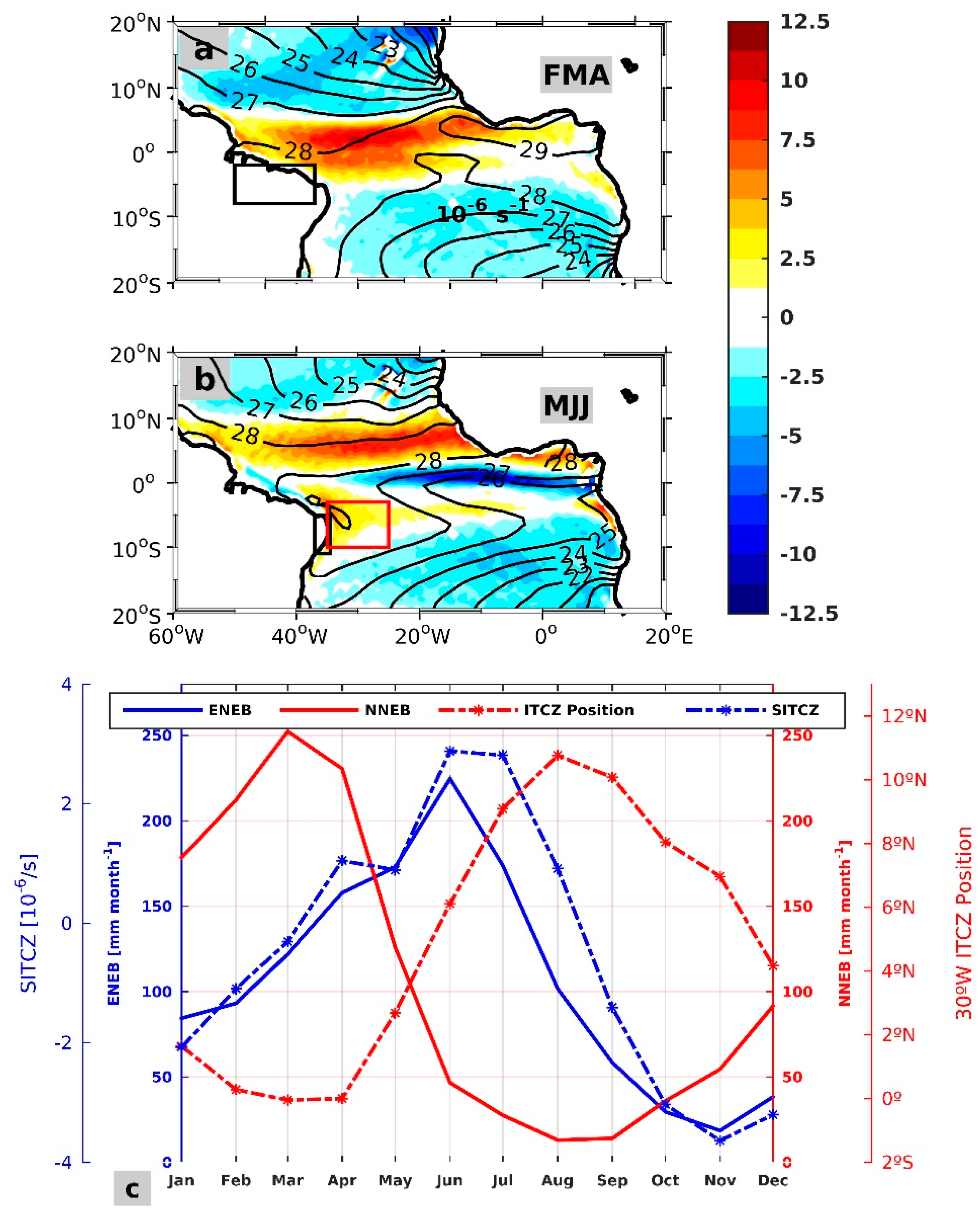
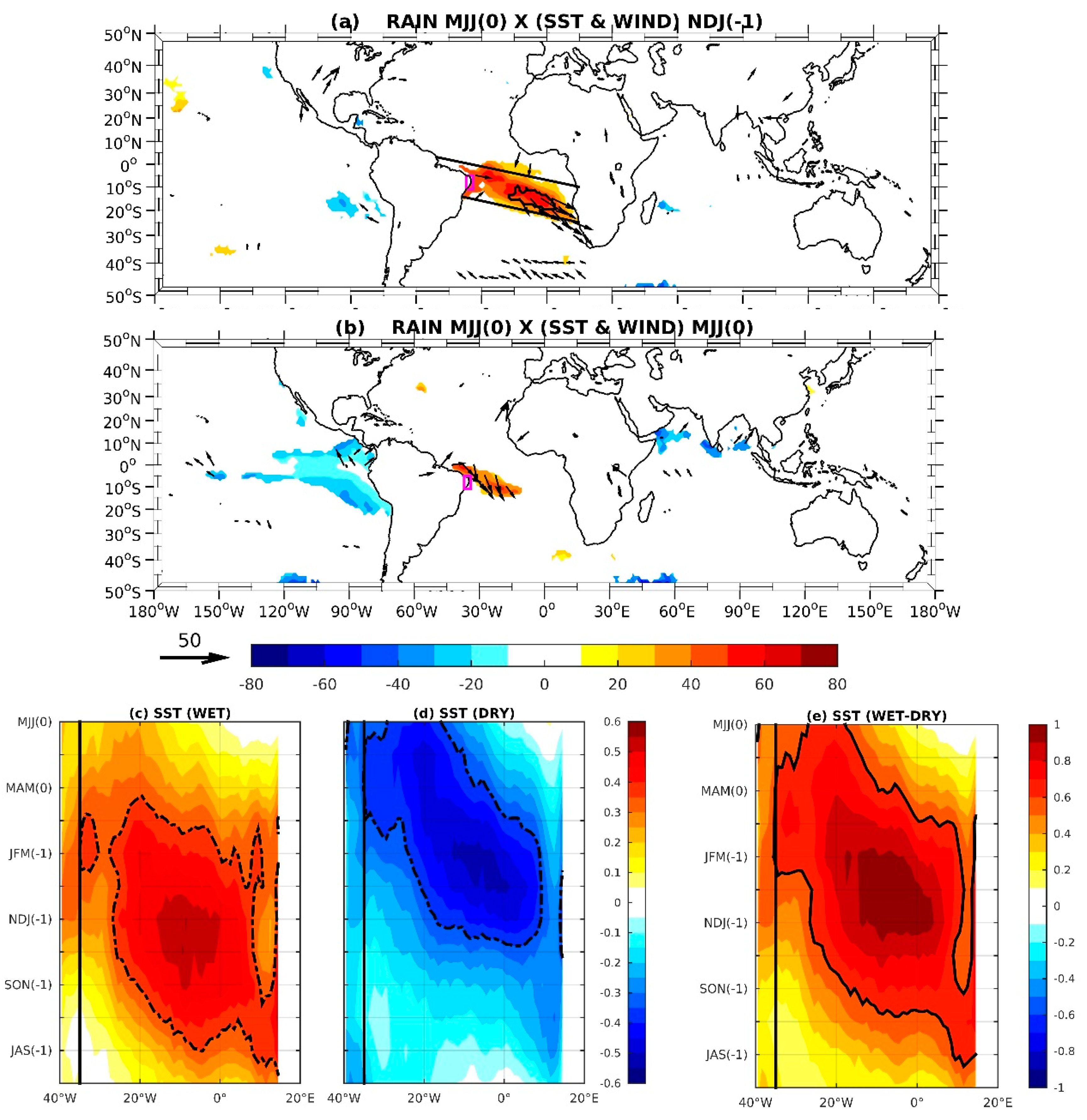
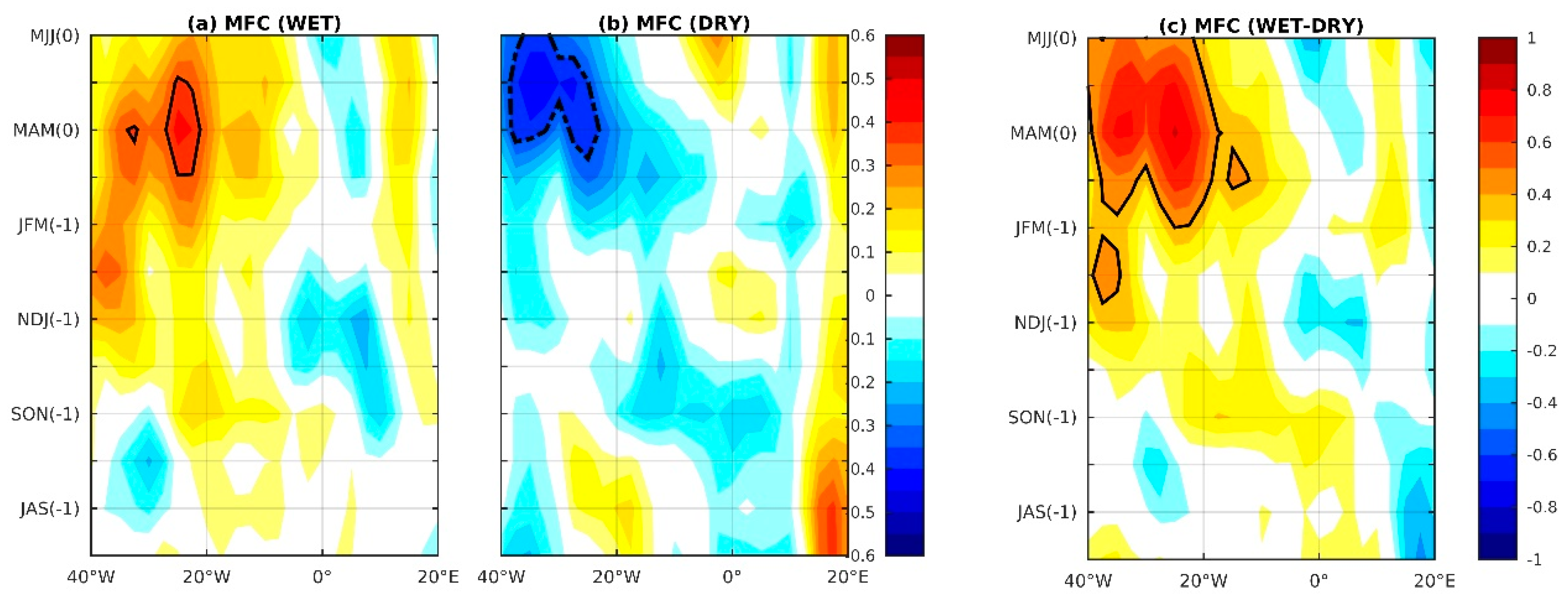
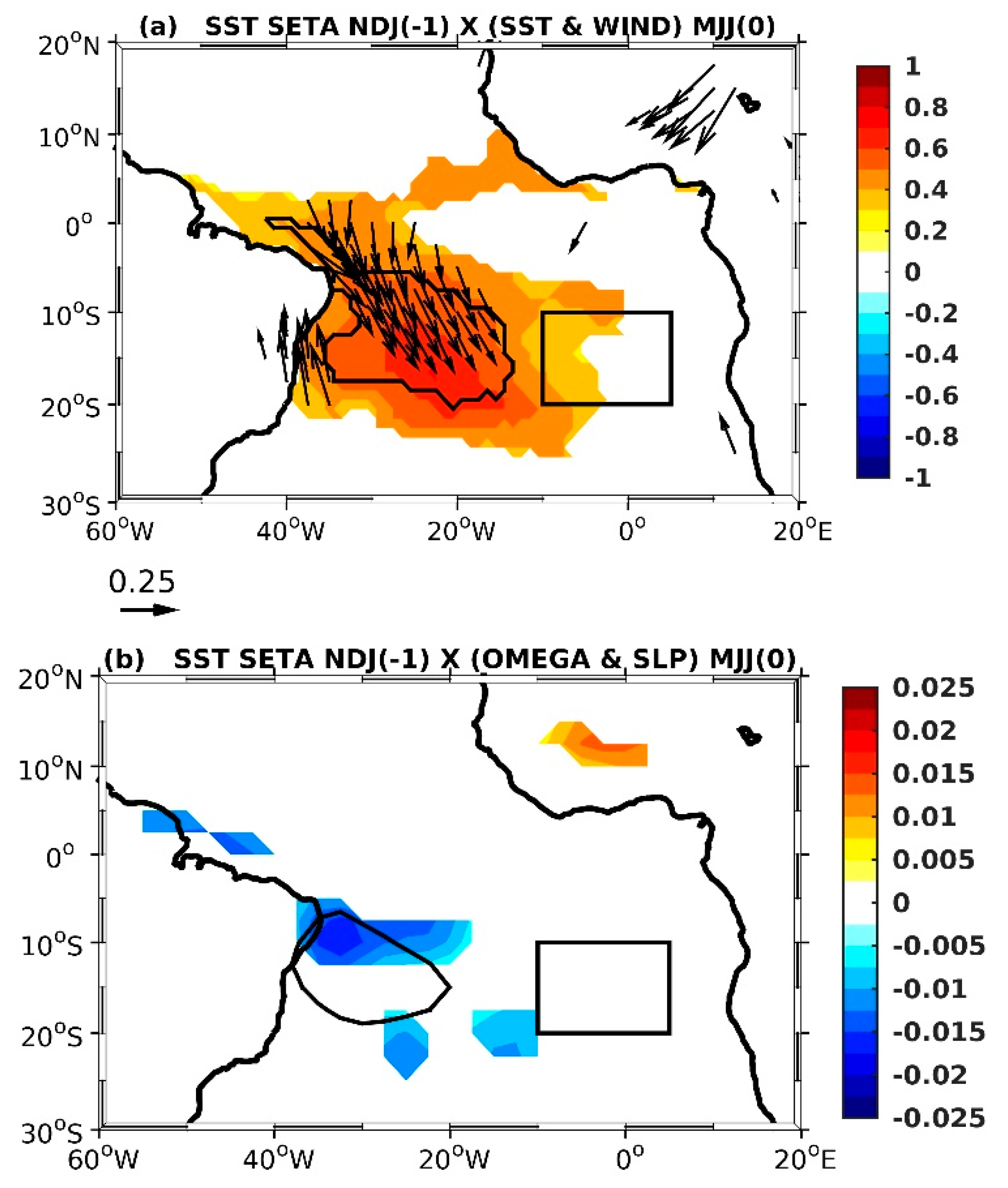
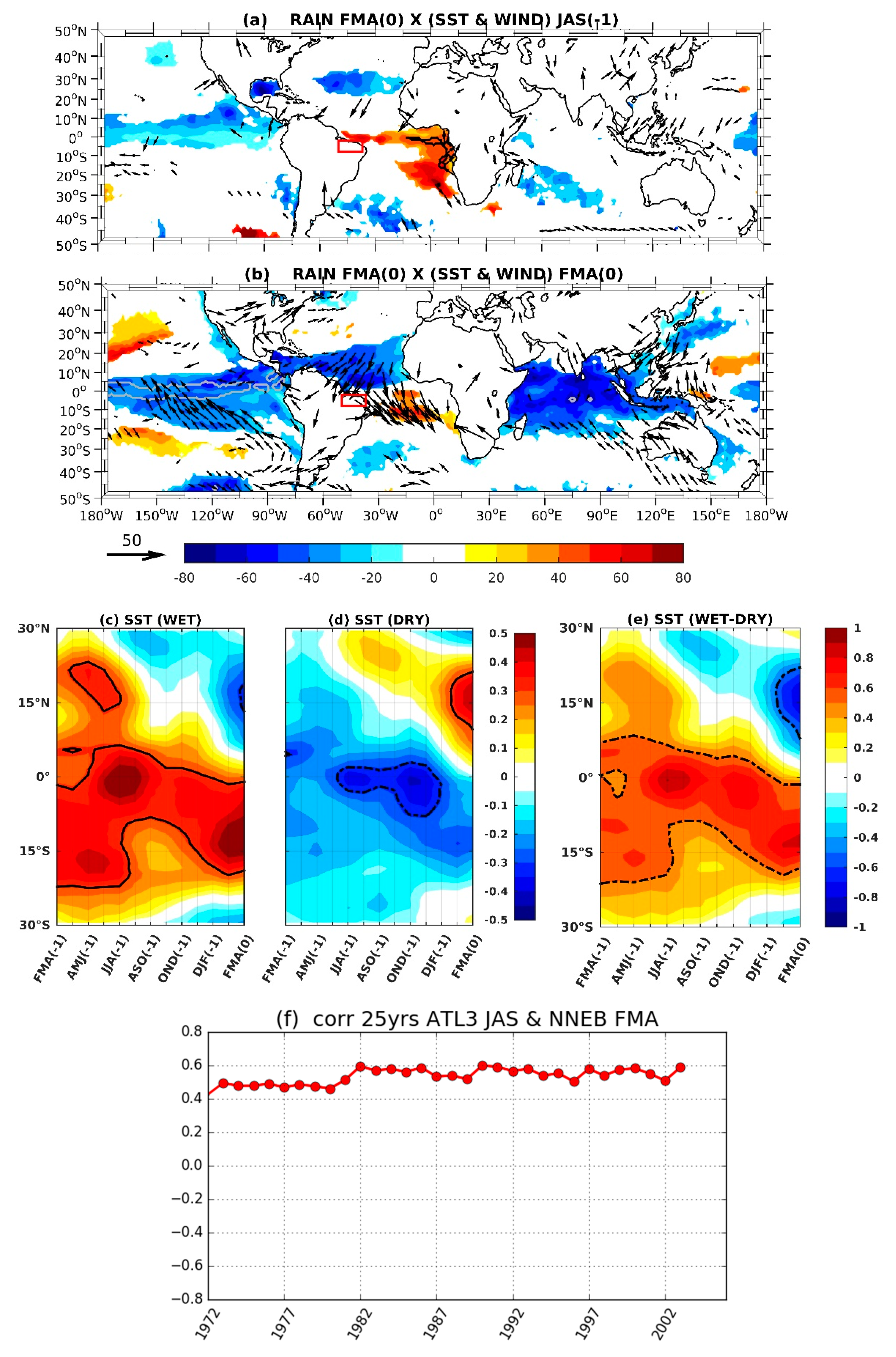
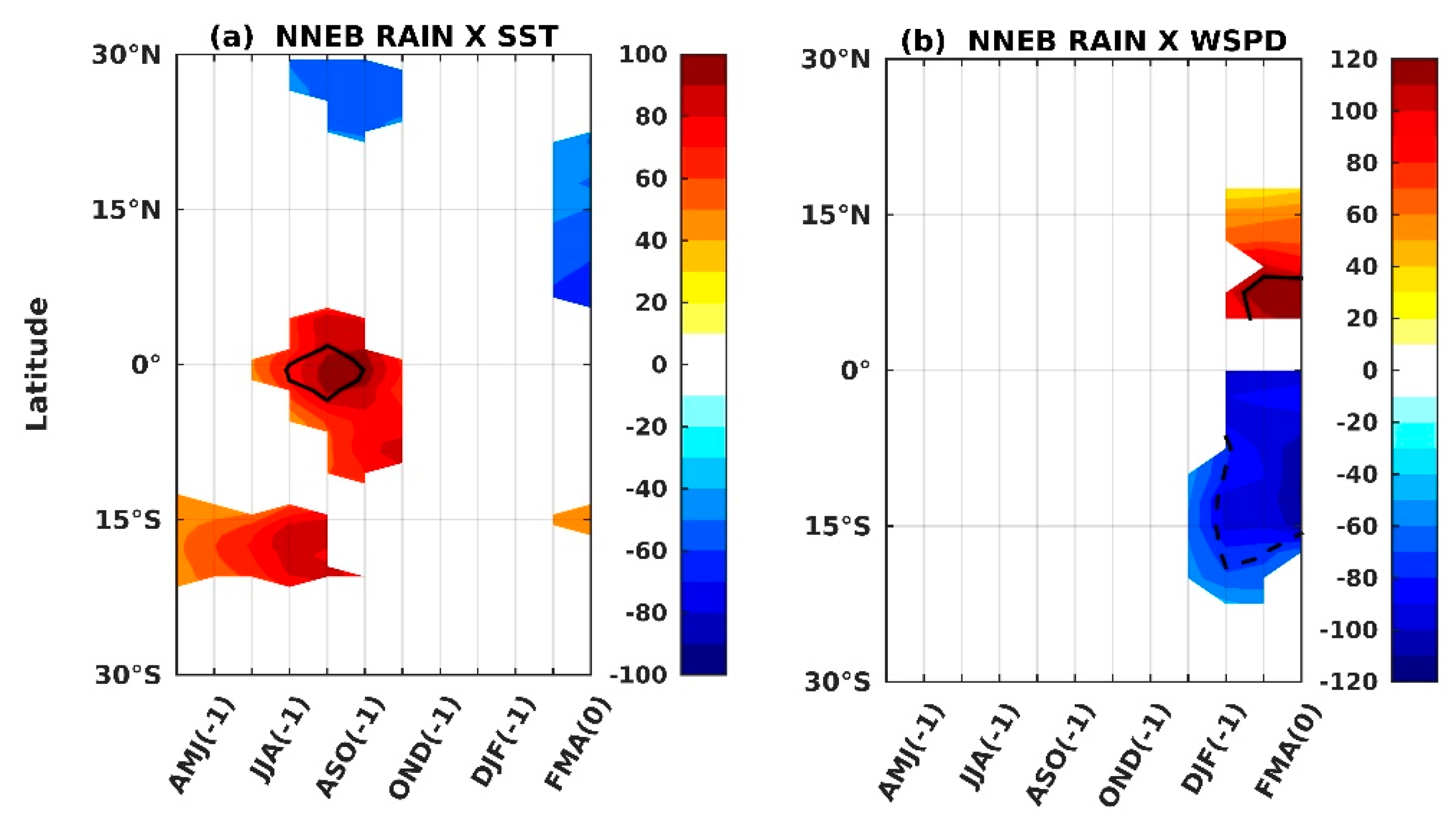
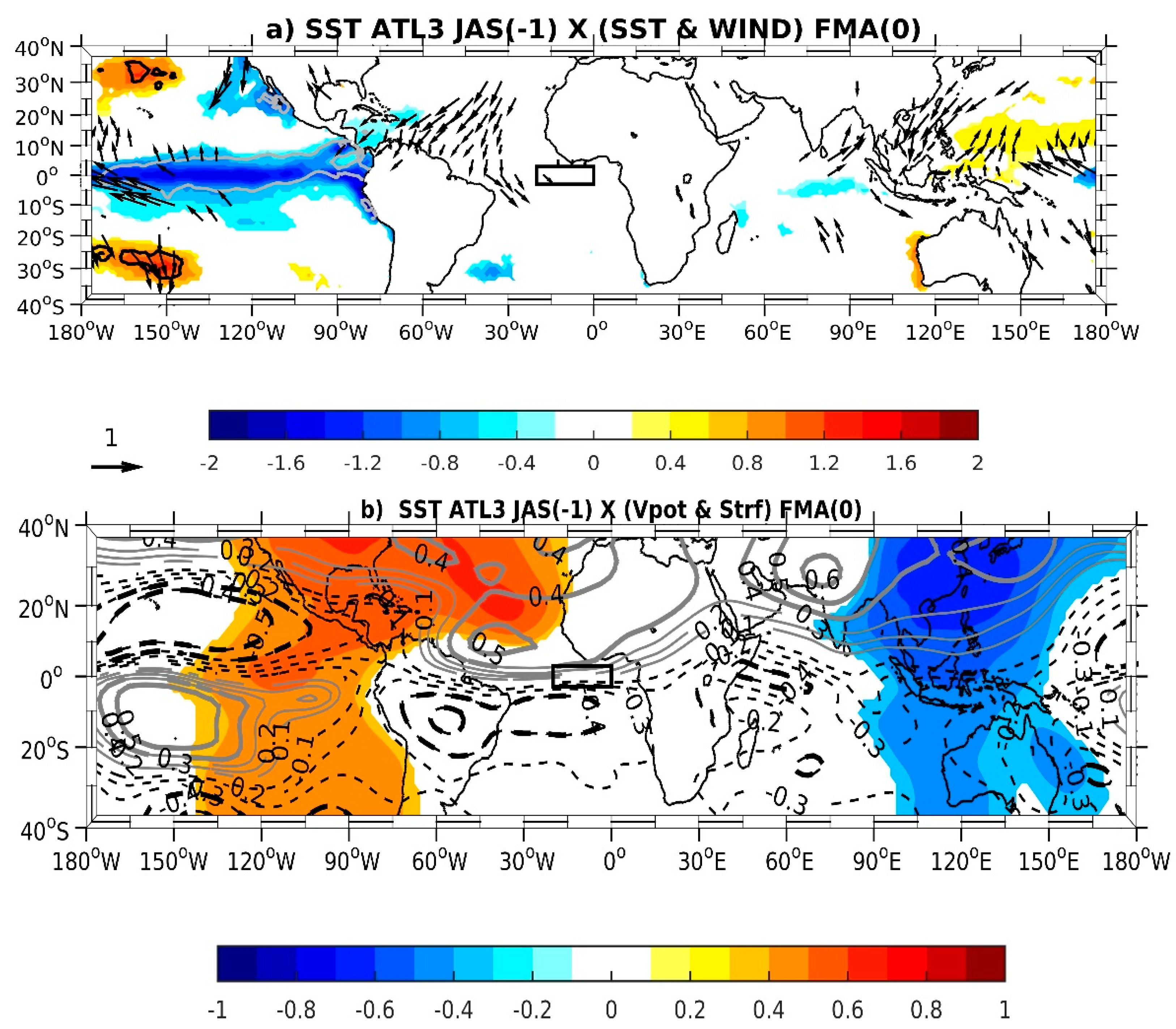

| Product | Description | Spatial and Temporal Resolutions | Data Availability |
|---|---|---|---|
| Land area precipitation | From the Global Precipitation Climatology Centre (GPCC). GPCC supplies the global land area precipitation calculated by objective analysis from dozens of thousands of rain gauge stations [41]. The full data reanalysis combined with monitoring (from 2014) version 7 is used in this work. | Monthly gridded data with 1° × 1° spatial resolution | From 1901 to present and available at [42] |
| Sea surface temperature (SST) | From the Objectively Analyzed Air-Sea Fluxes Project–OAFlux of Woods Hole Oceanographic Institution (WHOI). The OAFlux product is synthesized using National Centers for Environmental Prediction (NCEP1, NCEP2), European Centre for Medium-Range Weather Forecasts (ECMWF) ERA40, and ERA-interim Re-analysis [43,44,45] | Monthly data with 1° × 1° horizontal resolution | Available from 1958 to present at [46] |
| Reanalyzed Wind vectors, specific humidity, stream function, velocity potential and omega | From the National Centers for Environmental Prediction/National Center for Atmospheric Research-NCEP/NCAR [47] | Monthly data with regular horizontal grid of 2.5° × 2.5° and 17 pressure levels (mb) | From 1948 to present at [48] |
| Surface sea wind | Combination of Quick Scatterometer (QuikSCAT) and Advanced Scatterometer (ASCAT) satellite measurements [49] | Monthly data with 0.25° × 0.25° regular horizontal grid | QuikSCAT data are available from July 1999 to November 2009 and ASCAT data from May 2007 to present. These data are supplied by CERSAT, Ifremer and are available at [50] |
| Eastern NEB | Northern NEB | ||
|---|---|---|---|
| 1960 | 1988 | 1960 | 1988 |
| 1961 | 1989 | 1961 | 1989 |
| 1962 | 1990 | 1962 | 1990 |
| 1963 | 1991 | 1963 | 1991 |
| 1964 | 1992 | 1964 | 1992 |
| 1965 | 1993 | 1965 | 1993 |
| 1966 | 1994 | 1966 | 1994 |
| 1967 | 1995 | 1967 | 1995 |
| 1968 | 1996 | 1968 | 1996 |
| 1969 | 1997 | 1969 | 1997 |
| 1970 | 1998 | 1970 | 1998 |
| 1971 | 1999 | 1971 | 1999 |
| 1972 | 2000 | 1972 | 2000 |
| 1973 | 2001 | 1973 | 2001 |
| 1974 | 2002 | 1974 | 2002 |
| 1975 | 2003 | 1975 | 2003 |
| 1976 | 2004 | 1976 | 2004 |
| 1977 | 2005 | 1977 | 2005 |
| 1978 | 2006 | 1978 | 2006 |
| 1979 | 2007 | 1979 | 2007 |
| 1980 | 2008 | 1980 | 2008 |
| 1981 | 2009 | 1981 | 2009 |
| 1982 | 2010 | 1982 | 2010 |
| 1983 | 2011 | 1983 | 2011 |
| 1984 | 2012 | 1984 | 2012 |
| 1985 | 2013 | 1985 | 2013 |
| 1986 | 2014 | 1986 | 2014 |
| 1987 | 2015 | 1987 | 2015 |
| Eastern NEB | Northern NEB | ||||||
|---|---|---|---|---|---|---|---|
| NDJ SETA | NDJ NINO3 | NDJ SETA+NINO3 | JAS ATL3 | JAS NINO3 | JAS ATL3+NESTA | JAS ATL3+NINO3 | |
| Correlation | 0.51 | 0.29 | 0.76 | 0.52 | 0.27 | 0.65 | 0.53 |
| Rmse (mm) | 109 | 122 | 83 | 137 | 154 | 121 | 135 |
© 2019 by the authors. Licensee MDPI, Basel, Switzerland. This article is an open access article distributed under the terms and conditions of the Creative Commons Attribution (CC BY) license (http://creativecommons.org/licenses/by/4.0/).
Share and Cite
Hounsou-Gbo, G.A.; Servain, J.; Araujo, M.; Caniaux, G.; Bourlès, B.; Fontenele, D.; Martins, E.S.P.R. SST Indexes in the Tropical South Atlantic for Forecasting Rainy Seasons in Northeast Brazil. Atmosphere 2019, 10, 335. https://doi.org/10.3390/atmos10060335
Hounsou-Gbo GA, Servain J, Araujo M, Caniaux G, Bourlès B, Fontenele D, Martins ESPR. SST Indexes in the Tropical South Atlantic for Forecasting Rainy Seasons in Northeast Brazil. Atmosphere. 2019; 10(6):335. https://doi.org/10.3390/atmos10060335
Chicago/Turabian StyleHounsou-Gbo, Gbèkpo Aubains, Jacques Servain, Moacyr Araujo, Guy Caniaux, Bernard Bourlès, Diogenes Fontenele, and Eduardo Sávio P. R. Martins. 2019. "SST Indexes in the Tropical South Atlantic for Forecasting Rainy Seasons in Northeast Brazil" Atmosphere 10, no. 6: 335. https://doi.org/10.3390/atmos10060335
APA StyleHounsou-Gbo, G. A., Servain, J., Araujo, M., Caniaux, G., Bourlès, B., Fontenele, D., & Martins, E. S. P. R. (2019). SST Indexes in the Tropical South Atlantic for Forecasting Rainy Seasons in Northeast Brazil. Atmosphere, 10(6), 335. https://doi.org/10.3390/atmos10060335






